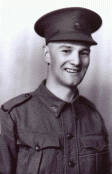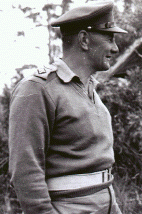 |
 |
![]()
| WO2 (Post War Lieutenant Colonel) Jack Willis Coombe |
| TX4204 2/4 Casualty Clearing Station |
Joined Militia pre war - Enlisted into 2/4 Casualty Clearing Station -Warrant Officer - To Malaya 1941 - Became POW February 1942 - Part of "A" Force to Burma May 1942 - Line joined October 1943 - To Thailand - Nakon Pathom Hospital Camp for 10,000 patients - Post war to Japan - Commissioned - CO School Army Health - Retired from Regular Army 1974 as Lieutenant Colonel.
 Jack Willis Coombe was born in Launceston on 4 March 1919. In the1930s he joined the Militia and attained the rank of Corporal. In 1939 he joined the Regular Army. He enlisted in Australian Imperial Force (AIF) 26 December 1940 as a member of the 2/4 Casualty Clearing Station.
Jack Willis Coombe was born in Launceston on 4 March 1919. In the1930s he joined the Militia and attained the rank of Corporal. In 1939 he joined the Regular Army. He enlisted in Australian Imperial Force (AIF) 26 December 1940 as a member of the 2/4 Casualty Clearing Station.
Jack was with the 2/4 CCS when it went to Malaya in 1941. After the capitulation of the Allies in February 1942 Jack, with many others, became a Prisoner of War (POW). Subsequently, he went to Burma as a member of the 2/4 CCS element which was sent to provide medical care to the 3,000 Australian POWs who made up "A" Force. They were shipped to Burma in May 1942 on two of the "Hell Ships" the Toyohashi Maru and the Celebes Maru. It seems he was at Tavoy for some months prior to moving to Thanbyuzayat, the point from which construction of the railway commenced in Burma.
The construction of the railway progressed south in Burma. At some stage Jack was at Retpu (30 Kilo Camp). It was here the POWs came under the influence of one Japanese Camp Commander Lieutenant Naito. Influence is a well chosen word, as he (Naito) was regularly drunk, and when in this state behaved in a sadistic manner. This behaviour was not necessarily restricted to the POWs or the coolies, it was often directed at his own Japanese and Korean guards. When he was drunk it was best to keep out of his way.
Nearly all the POWs had dysentery in one form or another. Jack had been to the latrine at night. On his way back to the attap hut, he was confronted by Lt Naito and a guard. Naito accused Jack of attempting to escape. Jack was initially taken to the guard house where he received a beating. Then Naito and the guard marched Jack off towards the cemetery. Naoto drew his gun and as this was happening the guard tripped Jack. Naito shot at Jack. One shot resulted in a through and through wound to his shoulder and the other missed. (Jack thought the guard had deliberately tripped him hoping the shot would miss. The guard had previously given him a gentle beating (see earlier in this paragraph).
Jack bolted back to the hospital hut shouting "That bastard shot me". The medical officers in the hut were Majors Fisher and Hobbs. They dressed his wound and put Jack on the slatted hospital bench (bed) next to Reuben Boxhall (Orderly Room Sergeant of the 2/4 CCS). A search was mounted in the camp but Jack was not located (the guards are said to have not been too diligent in their search).
Next morning Naito came into the hospital hut and stopped at Jack's feet. He then said "I Naito. I order you. Who shot you?" Jack said "I don't know Mr Naito."
"You get better quick or I send you to Japanese hospital". Naito also threatened the Medical Officers and told them not to report the incident.
Later Naito was terrorising the coolies and one of the guards ran from 30 Kilo Camp to 55 Kilo Camp to report his behaviour to senior Japanese. Following this Naito was bundled onto a truck with all his gear and that was the last they saw of him until they moved into Thailand when the line was finished. Whilst the POWs were in Thailand Naito attempted to ingratiate himself with the POWs from his former camp. It seems he may have realised the war had turned against Japan and he was attempting to get onside.
Following completion of the Railway (the line from Burma and the line from Thailand joined a short distance south of the Burma Thailand border) in October 1943, the POWs from Burma were moved south into Thailand. He was at various hospital camps which included Tamakarn, Chungkai and Nakon Pathom. He was on the staff at Nakon Pathom when the war ended. Whilst in Burma he observed the work of the Medical Officers. He had a very high regard for all the Medical Officers but, in particular, Lt Col Albert Coates acknowledging the large number of amputations which he did at 55 Kilo Camp.
 Jack continued in the Army after the war and was commissioned in 1951. He had many postings, which included, interalia , Japan as a member of the BCOF ( British Commonwealth Occupation Force), Staff Officer Medical Services (SOMS) Western Command, SOMS Southern Command, Second in Command and Commanding Officer School of Army Health 1967-68 and Head Quarters 3rd Military District.
Jack continued in the Army after the war and was commissioned in 1951. He had many postings, which included, interalia , Japan as a member of the BCOF ( British Commonwealth Occupation Force), Staff Officer Medical Services (SOMS) Western Command, SOMS Southern Command, Second in Command and Commanding Officer School of Army Health 1967-68 and Head Quarters 3rd Military District.
He retired in 1974 with the rank of Lieutenant Colonel and in 1976 became Honorary Colonel. Following his retirement he devoted 30 years to Legacy, including being President of the Victorian Branch.
Later he suffered from poor health and he and his wife Cynthia returned to Hobart. Jack Coombe died 6 June 2000 following a battle with cancer.
This article compiled by Lt Col Peter Winstanley OAM RFD Retired JP
Email peterwinstanley@bigpond.com website www.pows-of-japan.net
The assistance of Mrs Cynthia Coombe (Jack's widow) and Mr Reuben Boxhall (ex POW and former Orderly Room Sergeant 2/4 CCS) is acknowledged.
A separate account of the incident of the attempted murder of Jack can be found in
"Behind Bamboo" by Rohan Rivett in the chapter - Naito and the Reign of Terror.
|
|